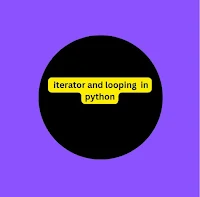In Python, iterators and looping are fundamental concepts that allow us to
traverse through sequences such as lists, tuples, dictionaries, and other
iterable objects. These concepts are widely used in many applications, from
simple iteration to complex data processing tasks.
1. What is an Iterator?
An iterator is an object that allows you to traverse through
a sequence of elements one at a time. Python provides built-in support for
iterators, which are used by loops such as for loops. An object
is called an iterator if it implements two methods:
-
__iter__(): This method returns the iterator object itself. -
__next__(): This method returns the next element of the sequence. If there are no more items, it raises aStopIterationexception.
Creating an Iterator:
You can create your own iterator by defining a class that implements both the
__iter__() and __next__() methods.
Example:
class MyIterator:
def __init__(self, start, end):
self.current = start
self.end = end
def __iter__(self):
return self
def __next__(self):
if self.current > self.end:
raise StopIteration
else:
self.current += 1
return self.current - 1
# Create an iterator object
iterator = MyIterator(1, 5)
# Loop through the iterator
for value in iterator:
print(value)
Output:
1
2
3
4
5
In this example, MyIterator is an iterator that iterates from
start to end. The __next__() method
increases the current value until it reaches the end and then raises the
StopIteration exception to signal that there are no more items.
2. Looping in Python
Looping is the process of repeatedly executing a block of code. In Python, there are two main types of loops:
- For Loop: Used to iterate over a sequence (like a list, tuple, or string) or an iterator.
-
While Loop: Used to execute a block of code as long as a
condition is
True.
a. The for Loop
The for loop in Python is typically used to iterate over an
iterable (like a list or a tuple) or an iterator. Python's
for loop simplifies working with iterators.
Syntax:
for item in iterable:
# code block
Example with List:
fruits = ["apple", "banana", "cherry"]
for fruit in fruits:
print(fruit)
Output:
apple
banana
cherry
Example with Range:
for i in range(1, 6):
print(i)
Output:
1
2
3
4
5
The range() function creates an iterator that produces numbers
from start to stop - 1. In this case, it produces
numbers from 1 to 5.
b. The while Loop
The while loop repeatedly executes a block of code as long as the
specified condition remains True.
Syntax:
while condition:
# code block
Example:
count = 0
while count < 5:
print(count)
count += 1
Output:
0
1
2
3
4
In this example, the while loop continues as long as
count is less than 5. After each iteration, count is
incremented by 1, and the loop stops once count reaches 5.
3. The break and continue Statements
-
break: Used to exit the loop prematurely. -
continue: Skips the current iteration and proceeds with the next iteration of the loop.
Example with break:
for i in range(1, 10):
if i == 5:
break
print(i)
Output:
1
2
3
4
In this example, the loop stops when i equals 5 due to the
break statement.
Example with continue:
for i in range(1, 10):
if i == 5:
continue
print(i)
Output:
1
2
3
4
6
7
8
9
In this example, when i equals 5, the continue
statement skips the current iteration, and the loop proceeds with the next
value of i.
4. Looping Through Iterators
You can also loop through iterators using for loops. Python
automatically handles the iteration using the __next__() method,
so you don't have to manually call next().
Example:
# Using MyIterator class from earlier
iterator = MyIterator(1, 3)
for value in iterator:
print(value)
Output:
1
2
3
In this case, the for loop iterates through the
MyIterator object, which internally calls
__next__() and stops when the
StopIteration exception is raised.
Conclusion
In Python, iterators are powerful tools that help traverse sequences. The
for loop works seamlessly with iterators, simplifying iteration
tasks. The while loop, on the other hand, allows for more control
over the flow based on conditions. Additionally, the break and
continue statements give you flexibility in managing loops.
Understanding these concepts and applying them to your Python programs will enhance your ability to handle repetitive tasks and manage control flow effectively.

Comments
Post a Comment